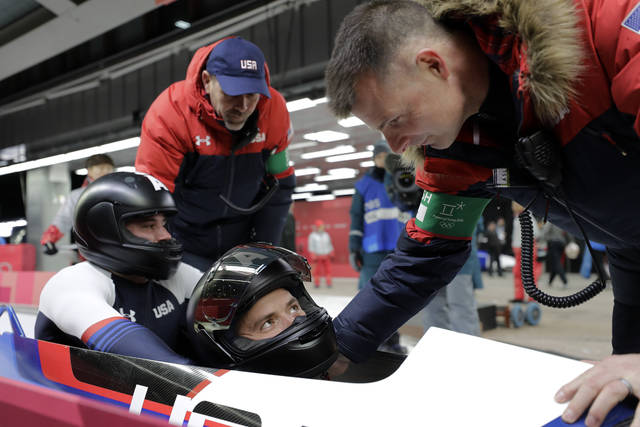PYEONGCHANG, South Korea — The U.S. wasn’t exactly counting on getting a medal in two-man bobsledding at the Olympics, which isn’t a surprise given how the Americans have claimed only one in the last 66 years.
They weren’t expecting to be this far back, either.
For the first time since 1994, an Olympics has come and gone with no U.S. sled finishing in the top 10 of the two-man competition. Justin Olsen and Evan Weinstock finished 14th on Monday night for the top American showing, the latest chapter in what’s been a disappointing series of results for U.S. sliders so far in Pyeongchang.
Nick Cunningham and Hakeem Abdul-Saboor were 21st, while Olympic rookies Codie Bascue and Sam McGuffie were 25th.
“It’s tough. We didn’t train so long to come here and place 25th,” Bascue said. “But I think we can put this behind us. We came in knowing our better shot was in four-man, so I think we can go into four-man with some confidence.”
There is some reason for hope.
Much like how Curve 9 was an issue for luge athletes, Curve 2 has been the one thwarting American hopes in bobsled and skeleton so far. But Cunningham and Bascue — both of whom clanged their way through Curve 2 in the opening two heats on Sunday — got through it cleanly Monday. So when four-man racing happens this weekend, they’ll at least know it’s possible.
“I fixed what I needed to,” Cunningham said.
He showed up Monday night with a clear mind, because he said that’s what longtime USA-1 driver Steven Holcomb would have done. Holcomb, the three-time Olympian and three-time medalist whose unexpected death last May still has the program reeling, had an uncanny knack for not showing his frustration after bad days at the track.
“He always kind of brushed it off like nothing was the matter, because he knew once he got to the bottom and crossed the finish line he couldn’t change it,” Cunningham said. “So I tried to take a page out of his book.”
The U.S. left Sochi four years ago with seven sliding medals — four in bobsled, two in skeleton, one in luge.
That total is not going to be matched in Pyeongchang, not even close.
So far in Pyeongchang, there’s only been Chris Mazdzer’s silver medal in men’s luge singles. The U.S. sliding medal haul should grow by at least one and possibly two with Elana Meyers Taylor and Jamie Greubel Poser both going into the women’s bobsled race that starts Tuesday as serious gold contenders. But the Americans won’t leave South Korea feeling as successful as they did when they flew out of Russia in 2014.
“Were we perfect? No,” Olsen said. “But we really gave everything we had to be as close to perfect as possible. This race will continue to humble people and so will this sport. You might have a down path one year and then come back, and you’re struggling a bit. We don’t walk away from this race upset at all. Evan and I would have liked to have push faster, but it’s not like we made mistakes.”
Luge was in a great spot to add more hardware to the U.S. collection; Erin Hamlin was in the mix in women’s singles all the way to the end, and the Americans barely missed bronze in the team relay. But in skeleton, the Americans weren’t close — the U.S. sent four sliders to the men’s and women’s races in Pyeongchang, and none of the four finished better than 11th.
That’s an Olympic first, and an Olympic worst for the Americans.
Now it’s bobsled off to a tough start, though the upcoming women’s race is the one that the Americans — rightly so — felt best about coming into these Olympics. And the U.S. also believes it could be in the four-man mix, especially with veterans and Olympic medalists Steven Langton (who will be in Bascue’s sled) and Chris Fogt (who will be with Olsen) having been spared pushing in two-man so they could be saved for the finale.
“We’re building,” Cunningham said.
———
More AP Olympics: https://wintergames.ap.org


